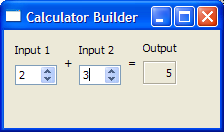Multiple Inheritance Example¶
Using a form created with Qt Designer in an application.
The Multiple Inheritance Example shows how to use a form created with Qt Designer in an application by subclassing both QWidget and the user interface class, which is Ui::CalculatorForm.
To subclass the calculatorform.ui file and ensure that qmake processes it with the uic, we have to include calculatorform.ui in the .pro file, as shown below:
<Code snippet "multipleinheritance/multipleinheritance.pro:0" not found>
When the project is compiled, the uic will generate a corresponding ui_calculatorform.h.
CalculatorForm Definition¶
In the CalculatorForm definition, we include the ui_calculatorform.h that was generated earlier.
from ui_calculatorform import *
As mentioned earlier, the class is a subclass of both QWidget and Ui::CalculatorForm.
class CalculatorForm(QWidget, Ui): Q_OBJECT # public CalculatorForm = explicit(QWidget parent = None) slots: = private() def on_inputSpinBox1_valueChanged(value): def on_inputSpinBox2_valueChanged(value):
Two slots are defined according to the automatic connection naming convention required by uic. This is to ensure that QMetaObject ‘s auto-connection facilities connect all the signals and slots involved automatically.
CalculatorForm Implementation¶
In the constructor, we call setupUi() to load the user interface file. Note that setupUi is a method of Ui::CalculatorForm.
def __init__(self, parent): QWidget.__init__(self, parent) setupUi(self)
We include two slots, on_inputSpinBox1_valueChanged() and on_inputSpinBox2_valueChanged(). These slots respond to the valueChanged() signal that both spin boxes emit. Whenever there is a change in one spin box’s value, we take that value and add it to whatever value the other spin box has.
def on_inputSpinBox1_valueChanged(self, value): outputWidget.setText(QString.number(value + inputSpinBox2.value())) def on_inputSpinBox2_valueChanged(self, value): outputWidget.setText(QString.number(value + inputSpinBox1.value()))
`` main()``
Function¶
The main() function instantiates QApplication and CalculatorForm. The calculator object is displayed by invoking the show() function.
if __name__ == "__main__": app = QApplication([]) calculator = CalculatorForm() calculator.show() sys.exit(app.exec())
There are various approaches to include forms into applications. The Multiple Inheritance approach is just one of them. See Using a Designer UI File in Your Application for more information on the other approaches available.
© 2022 The Qt Company Ltd. Documentation contributions included herein are the copyrights of their respective owners. The documentation provided herein is licensed under the terms of the GNU Free Documentation License version 1.3 as published by the Free Software Foundation. Qt and respective logos are trademarks of The Qt Company Ltd. in Finland and/or other countries worldwide. All other trademarks are property of their respective owners.

